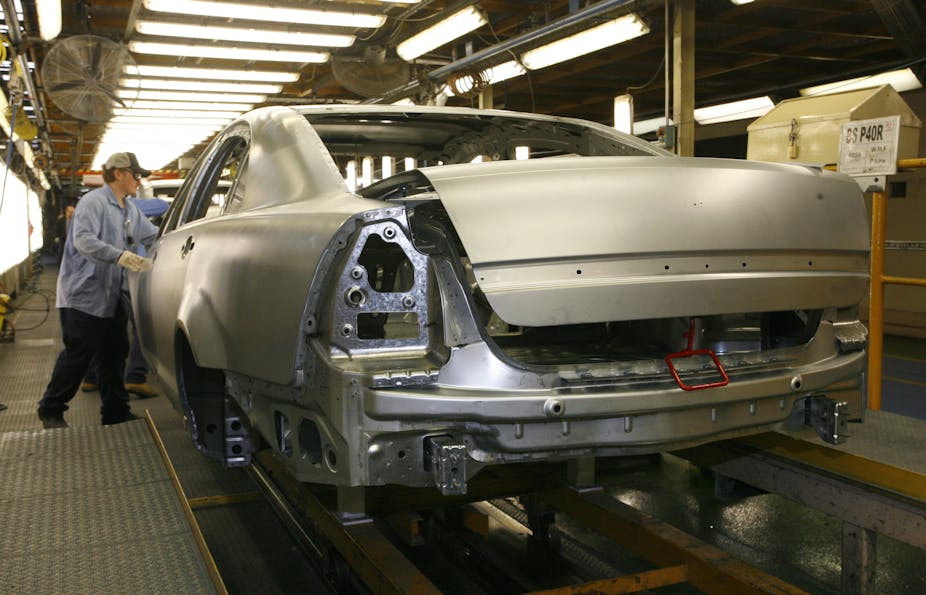Over the last few weeks, the cost of upheaval in the manufacturing sector has become ever more visible.
BlueScope Steel is to shed 1,000 employees while OneSteel has announced the loss of 400 manufacturing jobs. Losses such as these are inevitable and will continue as the Australian manufacturing sector adjusts to a changing economic landscape.
Universities can help, but how?
The plight of the manufacturing sector should not be a surprise. The sector’s contribution to Australia’s gross domestic product has been in steady decline, halving since the mid 1970s. Yet, as a nation, we are still ill-prepared.
Let’s first come to grips with today’s manufacturing sector. Gone, for the most part, is the reliance on large-scale manufacturers.
Instead, the sector is driven by flexible, small firms. Many are diversified, global and specialised, while others are locally focussed.
Firms no longer just manufacture. They provide services and export knowledge and expertise through information technology and people. They add value to imports on a relatively small scale to meet local demand. Some act as distributors and retailers as well as manufacturers.
Firms in the modern Australian manufacturing sector have very different ways of doing business to the manufacturers of the 20th century. This creates many more opportunities for new small and medium enterprises.
Universities now have a role to play that not only promotes growth and improvements in existing firms, but also growing the number of new firms that can survive and excel in this new environment.
Universities then need to rethink how best to respond to this change. Tradionally universities focus on teaching and research aimed at serving and improving existing firms. While this focus is worthwhile, it does little to create new businesses, new jobs and new sectors in our economy.
Improving existing manufacturing firms at a time when international markets offer far more favourable conditions in poorer economies only serves to continue the declining trend as firms get better at competing with lower-cost nations.
Instead, universities need to also focus on contributing more rapidly and effectively to the development of our economy. Engaging in development means creating industry and building new capabilities through technology and people.
These new capabilities should be seeded in new firms growing new economic activity. In addition to responding to the drivers of existing industry, the university sector needs to anticipate change and seed new industry.
A development focus means that universities need to do more. Simply preparing students for employment is not enough. Students should learn how to create enterprise and gain skills that help them to fulfil roles within new and smaller firms. Learning a single skill set falls short in preparing students for this new flexible and connected economy.
A development focus also means that research targets and incentives should move beyond creation of new knowledge and toward the application of new knowledge.
Research only for scientific breakthrough does too little to create new industry. Innovation policies and practices need to emphasise the creation of new enterprises that exhibit significant growth potential.
Universities need to be part of creating new industry activity in spaces where others are absent.
None of this may sound particularly new. Yet, despite continued efforts by governments and universities alike, there has been little gained or achieved in halting the slide of the manufacturing sector.
The reliance on innovation policies that build new knowledge, with a goal of improving the productivity of our manufacturing sector, misses opportunities to develop our economy by adding new layers.
Evidence suggests that in Australia a productivity-improvement approach has simply not worked. Instead we need more entrepreneurship that creates new economic dynamism.
Entrepreneurship in this form is not just simply new businesses either. We need new businesses applying new technologies.
Government and universities have responsibilities here. Government has a responsibility to attend to the conditions that support and encourage exploitation of new capabilities, markets and customers, supply channels, technologies and ways to maximise knowledge for new industry growth.
Universities have an equal responsibility and that is to be proactive to economic change by planting the seeds in the fertile industry ground that governments can provide.
If we are to truly reduce Australia’s reliance on the resources sector and build a world competitive manufacturing base we need to let go of the past. We need to pay attention to the change. We need to be serious about collaborative and proactive action between universities and governments to create spaces for new economic opportunities to arise. Our innovation agenda needs to change.

